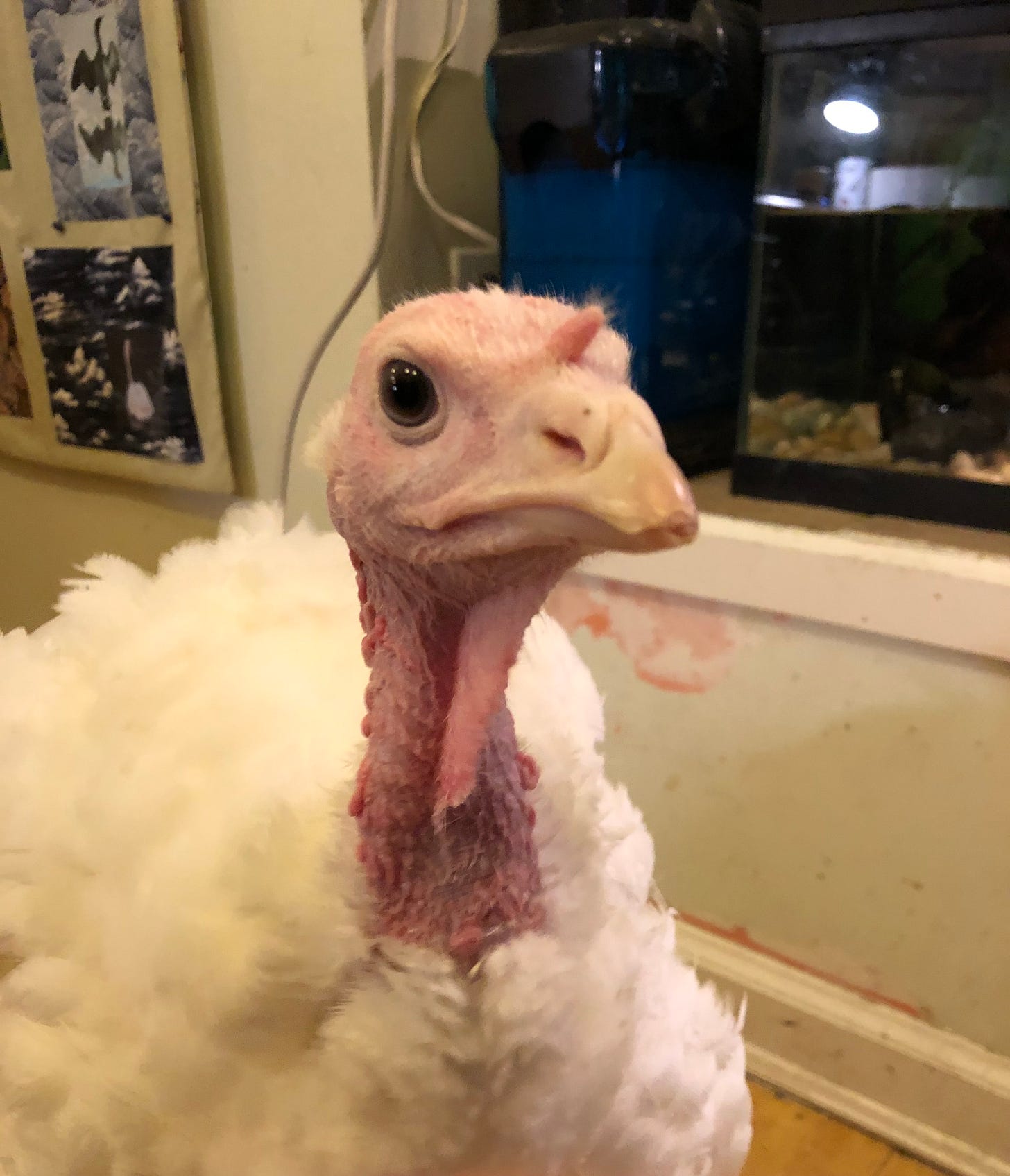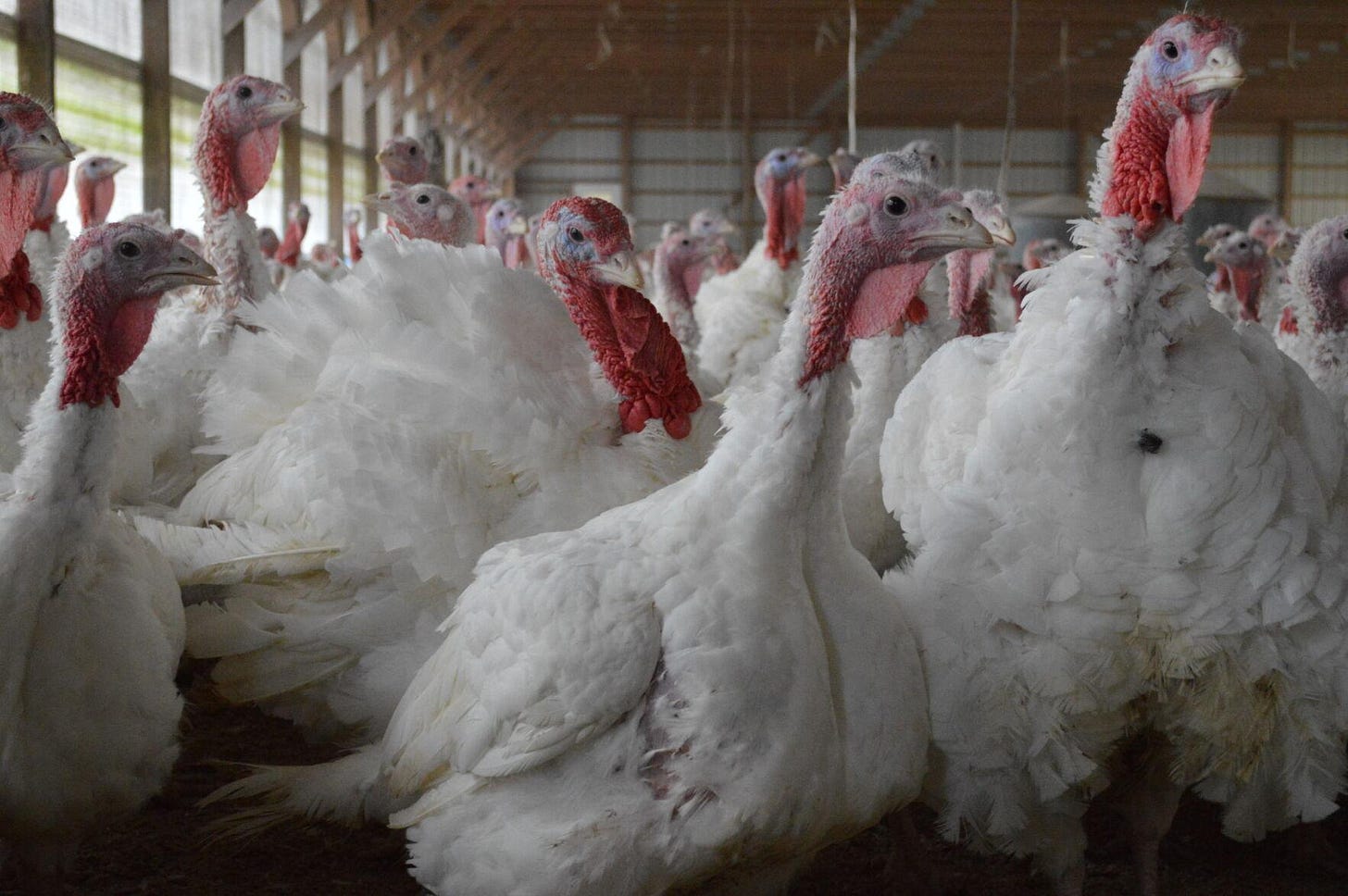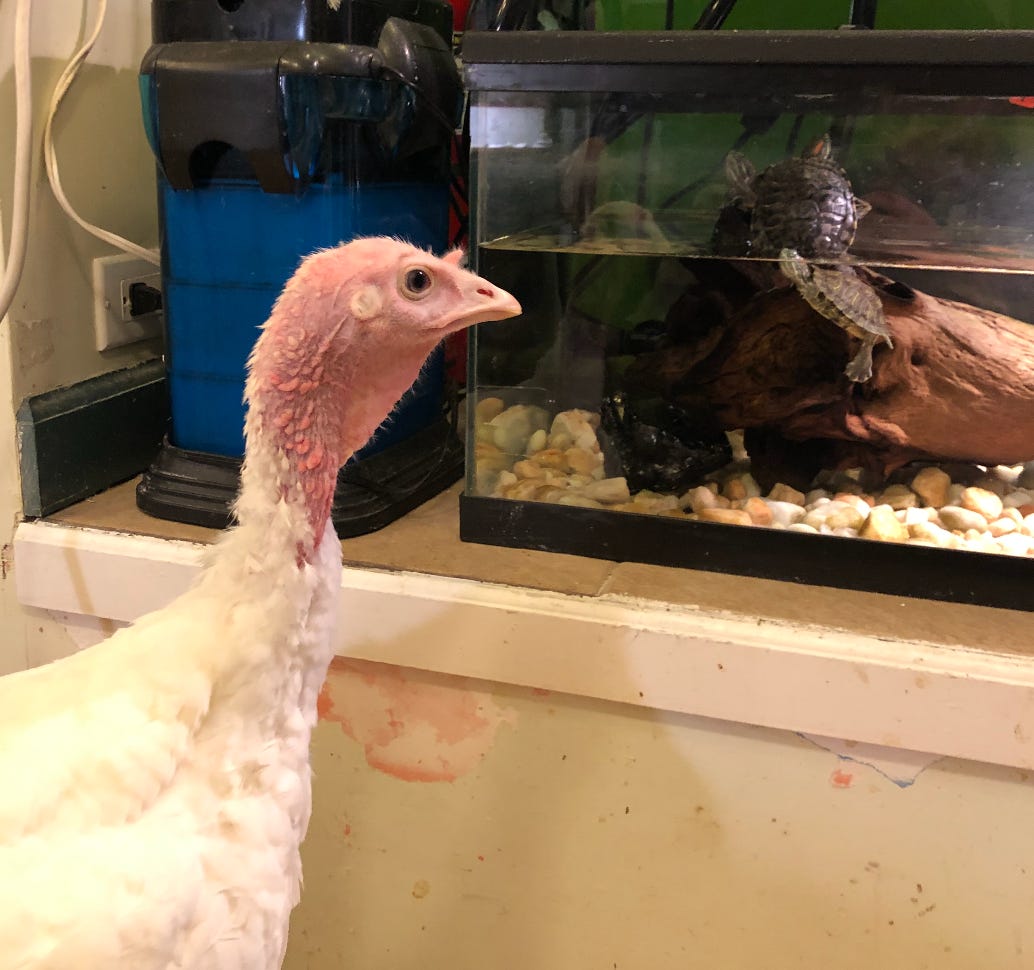Consider the Turkey
On wild turkeys, heritage turkeys, and the broad-breasted white
Yesterday, the day before Thanksgiving, I went out to run some errands. I had to buy bedding for the chicken coop, seed for my mother’s bird feeders, and (most importantly) some pre-rolls for myself. As I was checking out at the dispensary I wished the budtender a happy Thanksgiving, and she replied “You too. Enjoy the turkey!”
I didn’t say anything to her about how I don’t eat meat, but I always enjoy the turkey. I always have! I love all birds, but the turkey ranks high among them. I find turkeys fascinating and beautiful. Stately and deranged. I like their look, their gobble, their explosive flight… and I can relate to their nervous ways.
As wild turkeys continue to re-colonize the continent (and Hawaii) they have found themselves quite at home in suburbia. They didn’t just pop out of nowhere though. From the turn of the century to about the 1970s wild turkeys were exceptionally rare across North America. They’d been hunted and poached to near extinction and are considered a fabulous wildlife management and conservation success story.
Of course, the reason they were brought back from the brink was so that they could be hunted again. Hunting for wildlife conservation sounds like a bit of an oxymoron, but it’s true that hunters are sometimes our best stewards. To preserve patches of open woodland benefits the turkeys and those who’d like to kill them, but also all the other animals and plants that thrive in ideal turkey habitat. Still, I personally find there to be great value in the wild turkey beyond how fun it is to shoot or delicious it is to eat1.
I spend quite a bit of time thinking about turkeys every November. The imagery is everywhere. Both alive cartoon turkeys and dressed cartoon turkeys. Clip art, set dressing, SNL sketches. Turkey trots, facebook posts from an aunt that say “gobble til you wobble.” And of course, the turkey itself, which is unveiled on Thanksgiving day. It’s inescapable.
As I mentioned, I don't eat turkey and have not for several years. I am about six years into being a vegetarian2 (though I did another three in highschool). Not eating turkey is a very easy choice for me. I never really considered it to be one of the “good meats,” though I have eaten turkey gravy with a spoon on more than one occasion. Most people in my family don’t seem to care for turkey, yet they insist on having it every year anyways. The turkey’s value lies primarily in its use as a centerpiece and as a form of leftovers for turkey soup and sandwiches. The rest is pageantry.
This doesn’t bother me as much as it could since I have instilled a respect for turkeys, as well as most other birds, into my family without much choice on their end. Since I was little I have impressed and annoyed with facts about wild turkeys, their athletic capabilities, their conservation success, and tidbits about Benjamin Franklin and the first Thanksgiving.
I have also pestered and perturbed with insights about domestic, commercially farmed turkeys and the horrible lives they’re forced to lead. In high school, I looked into alternatives to a commercially-raised breed, but procuring a heritage turkey wasn’t such an easy task for a 15-year old. Still, it didn’t seem to matter to my family. Buying a turkey at the supermarket or ordering one from a restaurant is the easiest way to go–especially in a big family with many omnivorous mouths to feed.

Thanksgiving, however, is much more about the symbol of the turkey than it is the taste. Or at least, that’s how it seems to me, a Thanksgiving outsider. And I DO feel like a bit of an outcast not eating turkey on Turkey Day. Even the tastiest, most lovingly made lentils or meat-free lasagna just doesn’t say “Thanksgiving.” The tofurkey, a very sincere attempt at inclusion, does little but other the vegetarians. Even if you’re having a ham or some other type of fowl, something just isn’t right. And this is not by accident.
It shouldn’t surprise you to learn that even turkeys have lobbyists. The National Turkey Federation has worked hard to ensure that turkeys are the entree of choice at both Thanksgiving and many people’s Christmases. The wacky tradition of having the president “pardon” a turkey began with the National Turkey Federation gifting a pair of birds to Harry S. Truman (although Truman actually did eat those turkeys). Raising the profile of the turkey was key to ensuring that they’d remain a popular choice for the dinner table–especially considering how rare wild turkeys had become.
With a little help from their lobbyists, turkeys are now a fully-fledged American icon. Turkeys themselves, both the wild turkey and their Mexican cousin, the ocellated turkey, are endemic to North America. But as a symbol of God’s Country™ the turkey has been etched into American history. Breaking bread with the Wampanoags over a turkey carcass is a beautiful creation myth. And picture it: snapping a wishbone on Christmas. Now try: a father and son on a hunting trip, feathery carcass and shotgun a-slung over shoulders.
Norman Rockwell spells it out for us in Freedom From Want, the patriarch preparing to carve the turkey, freshly roasted by Cookie3, and ready to be eaten by his numerous, beautiful, and hungry progeny. It’s a gift to be simple, free, and full of turkey.

All of this would piss me off a lot less if there was a bit more consideration toward the turkeys themselves. Or even if people knew just a little bit more about the bird they were eating. While wild turkeys have garnered admirers, whether birder, outdoorsman, or neighborhood turkey-lover, the domestic turkey has not been so fortunate.
As far as farmed animals go, domestic turkeys are among those we rarely interact with. Sometimes you’ll see a heritage tom and hen at a petting zoo, but unless you live on a turkey farm, you’re probably not going to get many other chances to see a domestic turkey. Even still, the beautiful, and comparatively slender, heritage turkeys seen at petting zoos or apple orchards are but the blueprint for today’s commercial breed of choice, the broad-breasted white. These birds have been selectively bred to grow very large, very fast, and with much more white breast meat than any other variety of turkey in the history of their species.
Most people are vaguely aware of the fact that their meat–including turkey–comes from some sort of industrialized farming setup (a “family farm” as the National Turkey Federation would have me call it), and it is by design, and for biosecurity measures, that we don’t get an up close look at what goes on behind those barn doors.
When people do get to interact with turkeys, we think of these animals as being stupid, dirty, mean, ugly, fat, incapable, and above all else, doomed. Comically doomed, even. I think sometimes about my friend who gave up eating pork after learning about how smart pigs are, and how they are likely aware that they are about to die when they are taken to slaughter. It’s harder for most people to relate to birds and therefore easier to objectify them. I’m not saying that turkeys are as smart as pigs (they aren’t) or that my friend should give up turkey too (although…), but it’s easier to eat something you don’t know about or feel bad for. Especially if you think that creature was put on this earth to be eaten on a specific holiday.
During my stint as a volunteer at the Wild Bird Fund, I had the absolute privilege of spending some time with Tutu the turkey. Tutu, who now lives at Farm Sanctuary in Watkins Glen, came to WBF after she had been purchased from one of NYC’s slaughterhouses to be used in an art project. As inspiring as they are, turkeys are not meant to be art projects for the long term, and she was surrendered. Getting to know Tutu was a lot of fun. She was like a giant baby. A giant, hungry baby. She was sweet. She liked to have her wattles stroked. She was curious! When I looked into Tutu’s eyes I could see her looking back.
Despite the pleasures of getting to know Tutu, I was struck by the scars of her old life as dinner. The tips of her toes and the tip of her beak had been seared off. Standard practice in the poultry industry to prevent birds from pecking and clawing at one another in crowded conditions. Cutting off the tip of the beak is not like cutting your fingernails. Beaks have nerve endings, and debeaking is presumably very painful. And it doesn’t take much imagination to figure how painful it would be to have the tips of your toes cut off.

These aren’t some abnormalities that Tutu suffered in her journey to sanctuary. This is standard practice and it speaks to the way we value animal welfare standards for poultry. While we are seeing people held accountable for major cases of cruelty toward poultry, the National Turkey Federation and the various chapters of the Turkey Growers Association have carefully balanced the checkbook to consider whether and to what degree animal welfare plays a role in their product. Debeaking is considered a best practice when it is cheaper to sear the tips of the beaks off turkey poults than it is to give turkeys space enough so that they aren’t in danger of pecking one another to death. Cannibalized turkeys cannot be taken to market.
It is here, where the crux of my anger lies. I am begging you to try to see some value in the turkey beyond the price it can fetch or how moist you can make its meat. Wild, heritage, or broad-breasted white, turkeys tell a story about the way we are connected to our food.
In their 2,000 year history as a domesticated bird (and many thousands more as a wild species), turkeys have reflected various people and their unique relationships with food. This in turn reflects those people’s lifestyles and cultures, each in their own time with their own history. It is important to consider how the turkeys we eat today reflect who we are. Is this still the society of Rockwell’s Freedom from Want? Was it ever?
Turkeys–wild and domestic–are not stupid. They are important. They are important in both rural and suburban landscapes across North America and in our cultural identity. While the broad-breasted white is in no danger of extinction–we continue to be a society that champions cheap, readily available breast meat–they only exist in such large numbers because they reflect our current tastes. Similarly, the proliferation of the wild turkey and its reintroduction across the states was a reflection of our conversation priorities–and stakeholder values.
This Thanksgiving, like every Thanksgiving, I am thankful for turkeys. I am thankful that I live in a time and place where wild turkeys are a common sight. I am thankful for the hours I got to spend with Tutu. I very much hope that one day, when I have the chance to keep poultry again, that I’ll be able to have a turkey or two or ten in my flock.
Whatever your relationship with turkeys is like, I beg of you to please give them some consideration. It’s tough to be a turkey, held somewhere in the popular imagination between disrespect, industry, and tradition. So whether or not you’ll be having any turkeys on your table this Thanksgiving, give a little thanks and say a little prayer for the birds brought before you.
For further learning:
Temple Grandin gives you a tour of a National Turkey Federation farm and processing plant. This is the gold standard for commercial turkey production. It’s fair and nuanced, and from the master herself, but it’s unclear how widely implemented these practices are.
The Livestock Conservancy, a nonprofit dedicated to the preservation of heritage breeds of all types of livestock, including turkeys of course
From the White House, on the stupid-as-hell tradition of “pardoning” a turkey
The Ark of Taste, a catalogue of foods in danger of becoming extinct which includes several breeds of turkey
On Freedom from Want, some interesting context and history about the famed Rockwell painting
Turkeys… wearing shoes? A look at how heritage breeds used to be taken to market—and were sometimes shod by farriers
Tactfully, the Cornell Lab of Ornithology’s online encyclopedia, Birds of the World, describes our current era of turkey conservation as “a period of diverse stakeholder values.” As always, we must think of the stakeholders!
Let the record reflect, I on occasion eat fish and I understand that this is a willful misuse of the word “vegetarian.” My eating fish though is utterly opposed to my personal belief that fish do in fact experience sentience, feel pain, and have the capacity for complex thought. Not to mention the inexcusable impacts of commercial fishing on the planet, bycatch species, and the fishes themselves. I am a hypocrite! A hypocrite with a taste for seafood and a guilty conscience.
Contrary to popular belief this is not Granny. Mrs. Thaddeus Wheaton was the Rockwell family cook and modeled for this painting. And I can’t help but agree that “freedom from want” would include freedom from having to cook or do dishes.



